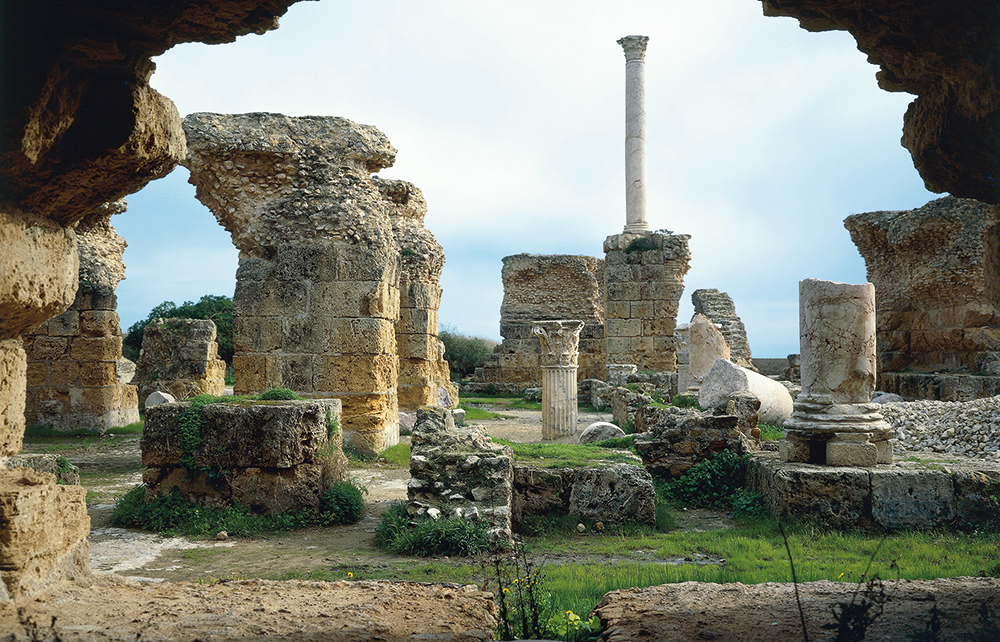It is a curious fact that between the foundation of Tunis by the Arabs in the 7th century and the foundation of Tel Aviv in the early 20th century no major cities were created on the shores of the Mediterranean. Even those cities were not quite new: Tunis, as Katherine Pangonis points out, was partly constructed out of rubble from Roman Carthage, situated nearby; and Tel Aviv originated as a Jewish suburb of Jaffa. Nor were ancient Mediterranean cities as sizeable as we imagine. Only Rome, Alexandria and Constantinople can be called megalopolises, and Constantinople lies much closer to the Black Sea than the Mediterranean. Pangonis’s lively new book therefore looks at five places whose significance was far greater than their relatively small size might suggest, places that were in some sense capitals, whether because they were centres of government (like Ravenna) or trade (like Tyre) or indeed culture (like Syracuse).
Although the emphasis is on ancient and medieval cities, an important dimension to the book is what happened to these places once their glory days were over. This does not simply mean recounting their history in more recent times, even when they became backwaters, but taking the reader through the modern streets, meeting today’s residents and even diving underwater to find the submerged remains of large parts of ancient Tyre. It means asking the inhabitants of Ravenna whether they are proud of their city’s mosaics, to which the perhaps predictable answer is yes, we are very proud of them but we never actually take a peek at them. In Antioch, it means scrambling over the ruins of modern Antakya in the immediate aftermath of the massive earthquake which levelled the city earlier this year. Following its abandonment in the 7th century, Carthage too has vanished, though its often forgotten revival as a major Roman city is well represented by the remains of massive baths, villas and spectacular floor mosaics.
Pangonis has an acute eye for literary traditions as well as archaeological remains. In her account of Carthage she details the various versions of the dramatic story of Dido, or Elissa, the queen who is said to have brought the first settlers to what would be the greatest city in the pan-Mediterranean trading network of the Phoenicians, and also became Rome’s mortal rival. But she also describes a more disturbing reality than the funeral pyre on which Dido supposedly immolated herself. The tophet, or children’s burial ground, appears to confirm the horrified insistence of Greek and Roman writers that the Carthaginians practised child sacrifice, apparently on a much larger scale than their ancestors in the Levant. These writers, along with Flaubert in his novel Salammbô, invented details of the rituals, which seem to have taken place especially at times of national emergency.
A feature of all these cities is that they were home to a variety of religious and ethnic groups. As Pangonis shows, intolerance existed alongside forbearance. The Roman inhabitants of the reconstructed city of Carthage were relaxed about which gods people worshipped, with the exception of that mysterious group of supposed trouble-makers, the Christians. Pangonis offers a haunting account of the martyrdom of Perpetua, who at the start of the 3rd century heroically faced not just a wild bull but a circus crowd baying for her blood.
Another century was to pass before the practice of Christianity became legal, so there were plenty more victims of the lions and tigers, even if, once again, the tales were sometimes enhanced for dramatic effect. But elsewhere a story of generally peaceful co-existence emerges, as in modern Antakya, where Jews, Christians and Muslims lived in harmony before the earthquake. Ravenna had its moment of toleration when its Gothic rulers fostered the Arian version of Christianity but did not suppress the Catholic church. On the other hand, the conquest of the city by Justinian’s general Belisarius in the 6th century saw the takeover of the mosaic-encrusted Arian churches, and a portrait of the Arian king Theoderic the Great was mischievously transformed into one of St Martin of Tours.
Pangonis’s combination of familiar and unfamiliar places is one of the great attractions of the book. Getting to Tyre – now a stronghold of Hizbollah – or ruined Antakya is a challenge for any traveller. But she eloquently evokes Carthage, Syracuse and Ravenna, all easily accessible, and manages to weave their stories together in a way that gives Twilight Cities coherence. This is a vividly written book to savour and enjoy, whether criss-crossing the Mediterranean or lounging in an armchair dreaming of it.







Comments